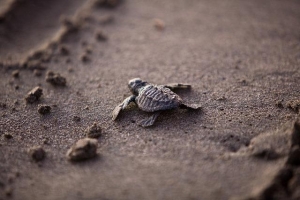Making sure sea turtles have a clear path to and from the Gulf of Mexico can be as simple as picking up sand buckets, filling in holes, dumping trash and removing beach canopies. All of these items make a day spent at the beach a fun time for your family. A blocked path, however, could negatively impact mama turtles coming ashore to lay eggs or hatchlings on their way to the sea. Share the Beach, Alabama’s sea turtle patrol, helps coordinate the many volunteers who safeguard the sea turtles’ nests and educates the public about our underwater friends.
Approximately 7,000 baby sea turtles hatched along the shores from Dauphin Island and Fort Morgan to Gulf Shores and Orange Beach in 2014. It was the biggest year for hatchlings that made it to the sea since the 2010 BP Oil Spill. Three species of turtles call the Alabama Gulf Coast home for part of the year: Loggerheads, Green and Kemp’s Ridley. Kemp’s Ridley turtles are classified as endangered while Loggerheads and Green turtles have a threatened status. 
The mama sea turtles come ashore in May to lay eggs, returning to the same area in which they were hatched. After hatching, the baby sea turtles make their way to the sea to begin their lives. Each mama sea turtle lays up to 110 eggs or more per nest. The eggs incubate for about 55 to 70 days. Sea turtle season usually ends in October. Currently, turtles are still hatching from their nests along Alabama’s white-sand beaches.
Sea turtles face a variety of natural hazards that can impede their trip back to the ocean – coyotes, foxes, thunderstorms, tropical storms and ghost crabs – just to name a few. The peril for the sea turtles doesn’t end after they hatch. They must make it to the sea to get to relative safety and begin their journeys. The path there can be obstructed by natural predators or by something as simple as a sand toy left on the beach. Any sort of obstacle, including artificial lighting, can make the turtle easy prey. Both the adult sea turtles and hatchlings use the moonlight and starlight to make their way to the Gulf of Mexico. Illumination from flashlights, patio lights or camera flashes can cause sea turtles to veer off course.
Once the hatchlings enter the sea, they are threatened by predators like bigger fish and sea birds. The danger ends when the baby sea turtles become too big to swallow.
What can you do to make the Alabama Gulf Coast more turtle friendly?
- Take home what you bring to the beaches of Gulf Shores and Orange Beach. It’s tempting to leave your tent structure up overnight. Don’t do it! Gather the sand toys, rafts, chairs and trash and put it where it belongs. Leave the coast clear for our nesting neighbors.
- Don’t use flash photography or flashlights on the beach at night.
- Turn off patio lights pointed at the beach and shield indoor lights from shining on the beach.
- Leave sea turtle tracks undisturbed.
- Do not disturb sea turtle nests.
Visit the Share the Beach website and find out how you can volunteer. But, in the meantime, we can all help by leaving only our footprints behind after a visit to Gulf Shores and Orange Beach.



Leave A Comment